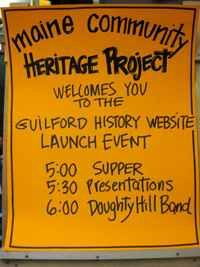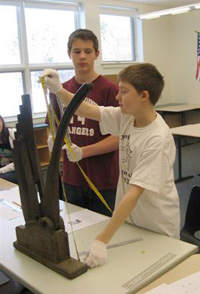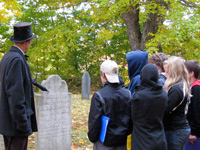
Since the early days of Maine Memory, there have been educational projects that have connected teachers and classrooms with community organizations beyond the school doors.
Every community in Maine has its own rich historical resources and unique stories to tell. At all grade levels, exploring local history is a great way to enhance classroom learning, get students involved in their community, and develop a broad range of important skills. It is also a great opportunity to build relationships with historical organizations in your community.
Benefits of participation include:
- exploring and interacting with local historical collections
- partnering with and learning from community members
- fulfilling a service- or experiential-learning component or requirement of the school curriculum
- developing technology and other 21st Century skills
- sharing work and community history with a vast and growing audience
Projects can be simple or elaborate. It all depends on your educational goals, curriculum and schedule flexibility, and time. Most community projects involve adding new material to the network. (For activities using content already on Maine Memory, visit In the Classroom.) Below are several types of community-based projects that schools can undertake, with samples of each from successful past projects.
Digitization Projects

Schools can work with local collecting organizations and institutions in their communities—historical societies, museums, archives-to add scanned and cataloged primary source material to Maine Memory Network. Organizations adding material to Maine Memory are called Contributing Partners (CPs). Sharing material on the network is the building block for all participation in MMN, and the foundation for all other projects. Maine Memory staff provides training and support.
Students can assist new CPs just getting started or work with veteran CPs to add additional items to their account. A yellow school bus icon appears next to individual items that students have helped get on the network. We recommend a minimum of 15 items digitized for a project; there is no upper limit.
Tasks Involved
Students can do some or all of the following, depending on the interest and flexibility of the CP partner and the school curriculum.
- One or more field trips to the historical partner organization
- Selecting and handling historic items (photographs, documents, artifacts, etc.)
- Historical research; possibly interviewing town historians
- Digitizing: scanning and/or digitally photographing items, uploading files to MMN, completing a MMN cataloging record for each
- Holding a community event showcasing the work of the project
How to Begin
- Contact your local historical society or archive to ask them to partner with you. Consult our Pre-Project Planning Guide for help.
- Download additional educator resources including a Student's Guide to Maine Memory, Student's Guide to Handling Historic Materials, Student Scanning Guide, and other materials.
- See How to Contribute: Collecting Organizations to find out more about how CPs apply and add material to Maine Memory. Encourage your local historical society to review the information.
- Contact us to discuss your plans, develop a timelines, and schedule training.
- See examples of digitization projects completed by schools and historical societies working together.
Online Exhibit Projects

If you want to take your group of students one step further than helping to put individual primary source materials on Maine Memory, an Online Exhibit project may be for you. Online exhibits employ the user-friendly Album and ExhibitBuilder tools embedded in MMN to tell illustrated stories and explore topics, themes, and events in a community's history. Maine Memory staff provides ongoing training and support.
Tasks Involved
Students can do some or all of the following, depending on the interest and flexibility of the CP partner and the school curriculum.
- All Digitization tasks listed above
- Brainstorming and winnowing viable topics
- More intensive research, interviews with local experts, and possibly additional field trips
- Outlining and drafting a narrative, potentially with multiple sections
- Selecting digitized images to illustrate that narrative; creating a storyboard of exhibit flow
- Constructing the exhibit online
- Holding a community event to show off the exhibit
Some teachers have developed entire courses around a Maine Memory online exhibit project, but the project can be made to fit the unique needs, interests, skills, and schedules of your students. To learn more from veteran Maine memory teachers, please visit our Teacher Advisory Board page.
How to Begin
- Contact your local historical society or archive to ask them to partner with you. Consult our Pre-Project Planning Guide and Project Planning Worksheet for Educators for help.
- Download additional educator resources including an Educator's Guide to Online Exhibits, Educator's Guide to Albums, and other materials.
- Contact us to discuss your plans, develop a timeline, and schedule training(s).
- See examples of online exhibit projects completed by schools and historical societies who worked together.
- View additional examples of exhibits in the Exhibits section.
Community History Websites

Building a community history website is the most intensive project type available to a school group. Community history sites are housed in a special section of Maine Memory Network and showcase multiple aspects of a Maine town or city's history. Schools must work with at least two other community organizations-one of which must be a historical partner-to undertake this project. Traditionally, the second partner has been the local public library. Maine Memory staff provides training, support, resource material, and will attend team meetings.
Community sites employ the user-friendly ExhibitBuilder and SiteBuilder tools embedded in MMN to tell illustrated stories and explore topics, themes, and events in a community's history. Typically there is a broad narrative of the town's history, and five or more focused exhibits about specific aspects of that history. Project teams choose a template (e.g. color and layout), add pages and text, and insert and arrange images and links.
The origin of the Community History Website model is the Maine Community Heritage Project, which ran from 2008-2013. Please note that there are no longer stipends available for these projects.
Tasks Involved
Students can do some or all of the following, depending on the interest and flexibility of the other organizational partners and the school curriculum.
- Drawing up list of project goals; identify partnering organization skills/resources; identify all local historical resources available for project; create custom project plan and deadline-driven calendar
- Participating in regular meetings between the project team and MMN staff
- All Digitization & Online Exhibit tasks listed above: minimum of 50 items digitized and 5 exhibits created
- Development of the site: page components, organization, navigation, number of exhibits
- Construction of site using SiteBuilder tools
- Holding a community event to unveil the site
How to Begin
- Review the components of the Maine Community Heritage Project.
- Download the Educator's Guide to Community History Websites and additional educator resources. (Please note that there are no longer stipends available for these projects.)
- Contact your local historical society, public library, and/or other partner to get their commitment on the project.
- Contact us to discuss your plans and schedule a meeting.
- See examples of community history sites already on MMN.


